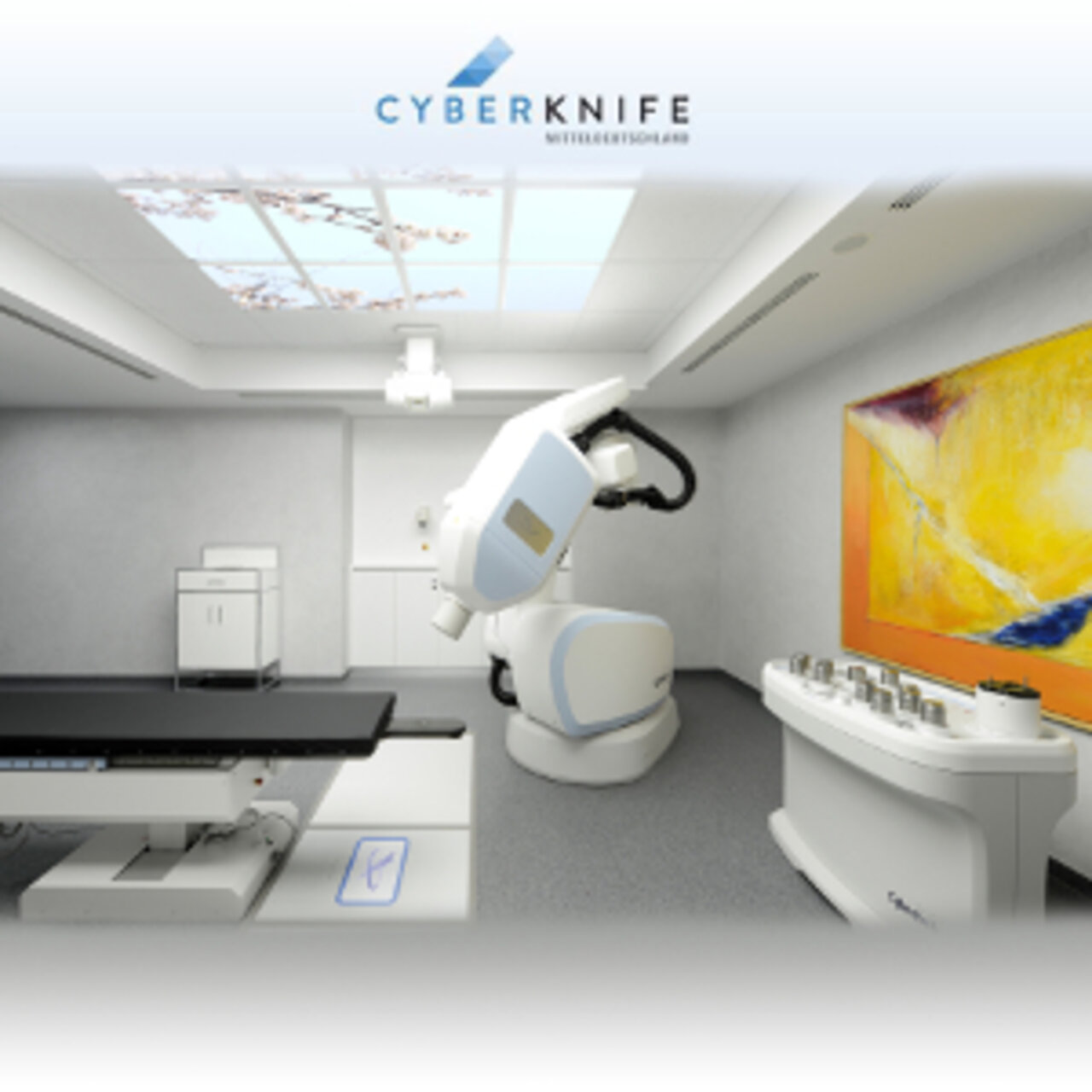Specialists in Stereotactic radiosurgery
5 Specialists found
Radiological Alliance – Interdisciplinary Center for Radiosurgery
Radiation Therapy / Gamma Knife
Hamburg
Information About the Field of Stereotactic radiosurgery
What is Radiosurgery?
Radiosurgery is a radiotherapeutic procedure in which a small, clearly defined tumor is irradiated with high precision. The diameter of the target tumor can be between 0.5-4cm. The healthy tissue is spared due to a steep energy drop of the applied radiation at the tumor border.
Which Irradiation Methods Are Used for Radiosurgery?
Linear Accelerator
Modern high-performance linear accelerators (= LINAC-based) can be offered for radiosurgery. These are particle accelerators that speed up particles by voltage and direct them in their favored direction with magnetic fields.
CyberKnife
The CyberKnife is a radiosurgical radiotherapy device, which can be used to treat tumors throughout the body, in contrast to the gamma knife, which field of application is limited to the head. This technology uses high-dose photon radiation from a linear accelerator and directs it precisely to the defined target with the help of a freely movable robot arm.
Gamma Knife
The gamma knife is a radiosurgical radiotherapy device. It is used exclusively for irradiating intracranial processes. The device contains cobalt-60 sources, which are arranged in a hemispherical shape. Radiation from 192 sources is directed at the target tumor so that they meet there and release their energy targeted. During irradiation, two X-ray cameras monitor the patient's position and correct any fluctuations in relation to the planning images in real-time.
Advantages of Radiosurgery Compared to Conventional Radiation Therapy
Radiosurgery enables precise therapy of body regions that are difficult to access surgically. It can also be used to treat body parts that are "hidden" in the middle of the body so that, in contrast to conventional radiotherapy, the tissue is not damaged on the way from the skin to the tumor, which is often tumors in the skull, since access is made difficult by the skull bone. The drop in dose at the tumor border spares the surrounding tissue so that the expected side effects are lower, and the therapy is generally better tolerated, which opens up new treatment options for older patients and patients with concomitant diseases.
Which Tumors Can Be Treated By Radiosurgery?
Brain Metastases
Patients with a primary tumor outside the brain suffering from metastases inside the skull can be treated with radiosurgery. Patients with up to four 3cm large metastases are eligible.
Tumors of the Meninx (Meningiomas)
Tumors located within the skull bone are difficult to access and are also often located close to sensitive structures such as brain vessels. Therefore, these tumors are particularly suitable for radiosurgery. Meningiomas are characterized by a low-risk profile and small size increase. They can be irradiated after a complete surgical removal or after incomplete removal.
Acoustic Neuroma
Acoustic neuroma was the first tumors to be treated by radiosurgery. The aim is to stop the growth of cancer, which is successful in 90% of cases. Non-invasive hearing can be preserved in most cases.
Vascular Malformations (Arteriovenous Malformations, Cavernomas)
Malformations of the brain vessels (cavernomas, arteriovenous malformations) in functionally important brain regions can be treated with radiosurgery. These malformations are characterized by weaker vessel walls and represent a high risk of stroke. The radiosurgery of these malformations, which are not surgically accessible due to their elective position, significantly reduces the symptomatic bleeding rate.
Functional Neurosurgery - Facial Pain
Radiosurgery is used in the treatment of facial pain at the base of trigeminal neuralgia. Patients with multiple sclerosis or skull base meningiomas with infiltration of the trigeminal nerve also benefit from radiosurgical therapy.
Side Effects of Radiosurgery
Side effects occur very rarely and strongly depend on the treated disease, the localization of the diseased tissue, and the required radiation dose. Therefore, it is not possible to make a general statement on this in advance. Individual risks for specific side effects will be discussed in preliminary consultation with the doctor in charge.
Irradiation of tumors in the auditory system can subsequently lead to dizziness or hearing loss or even deafness. In general, treated tumors can swell, resulting in pressure symptoms if the swelling occurs in the skull. At higher doses, so-called radio-necrosis can occur, i.e., tissue decay due to external influences.
Radiosurgery Costs and Cost Acceptance By Health Insurance Companies
Typical costs range around 7,000 to 10,000 euros. In many countries, e.g., the Netherlands and France, radiosurgery is an integral part of standard care and is covered by health insurance. In Germany, the costs of radiosurgical treatment are not yet reflected in the general outpatient reimbursement catalog of the statutory health insurance funds, so that automatic billing using the insurance card is not possible. In principle, however, statutory health insurance funds can cover the costs of the therapy. Decisions can be made on a case-by-case basis, and contracts for integrated care can be concluded with medical service providers.
Which Doctors Are Specialized in Radiosurgery?
Those who need a doctor want the best medical care. Therefore, the patient is wondering where to find the best clinic. As this question cannot be answered objectively, and a reliable doctor would never claim to be the best one, we can only rely on the experience of a doctor.
We help you to find an expert for your disease. All listed doctors and clinics have been checked by us for their outstanding specialization in stereotactic radiosurgery and expect your inquiry or treatment request.
Cyberknife Locations in Germany and Switzerland
Centers in Germany
- Munich: European Cyberknife Center Munich-Großhadern
- Güstrow: Sapphire radiosurgery center northern Germany
- Bochum: German Cyberknife Center
- Berlin: Charité Cyberknife Center
- Hamburg: Cyberknife Center Hamburg
- Cologne: Cyberknife of the University Hospital Cologne
- Erfurt: Cyberknife Center Central Germany
Centers in Switzerland
- University Hospital Bern
- Gammaknife Center Zurich
Gamma Knife locations in Germany and Switzerland
Gamma Knife treatments for the head are possible in Germany:
- Krefeld: Gamma Knife Center Krefeld
- Aachen: University Hospital RTWH Aachen
- Frankfurt: Gammaknife Frankfurt
- Hannover: Gammaknife Center Hannover
Gamma Knife centers in Switzerland:
- Zurich: Klinik im Park and Klinik Hirslanden
- Lausanne: Hirslanden and Clinique Cecil
Sources:
- Tej D.Azad, Rogelio Esparanza: Stereotactic radiosurgery for metastasis to the craniovertebral junction preserves spine stability and offers symptomatic relief, J Neurosurg, Spine Volume 24, February 2016.
- Piper: Innere Medizin . 2. Auflage. Springer 2012, ISBN 978-3-642-33107-7.
- Hien: Praktische Pneumologie . 2. Auflage. Springer 2011, ISBN 978-3-642-10209-7.
- Wannemacher et al. (Hrsg.): Strahlentherapie . 2. Auflage. Springer 2013, ISBN 3-540-88304-5.




